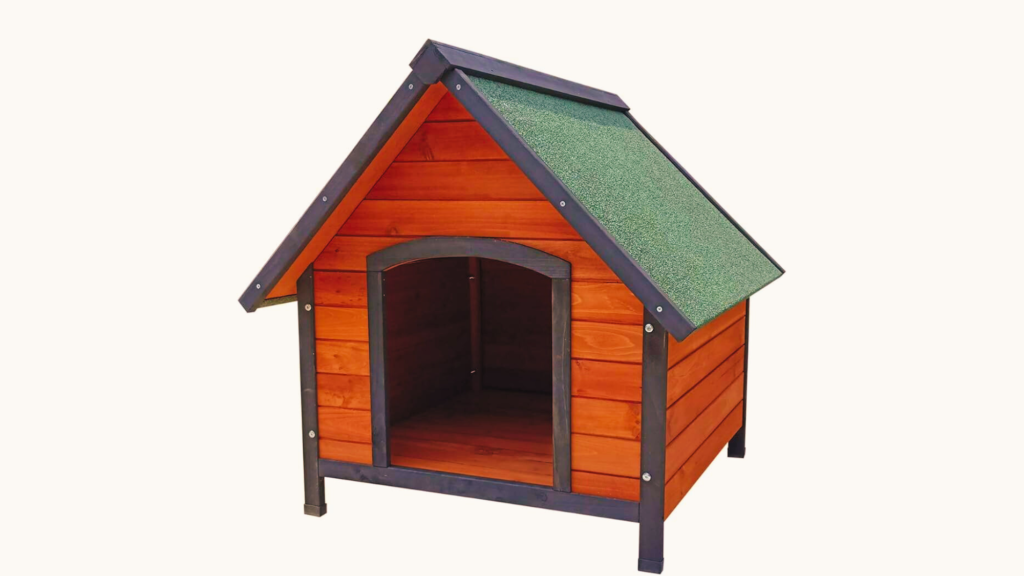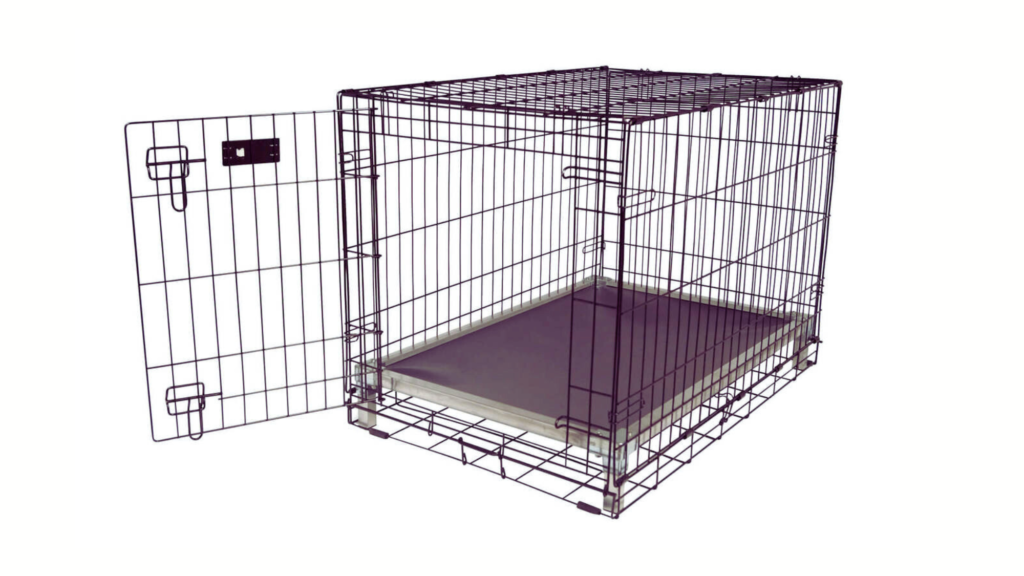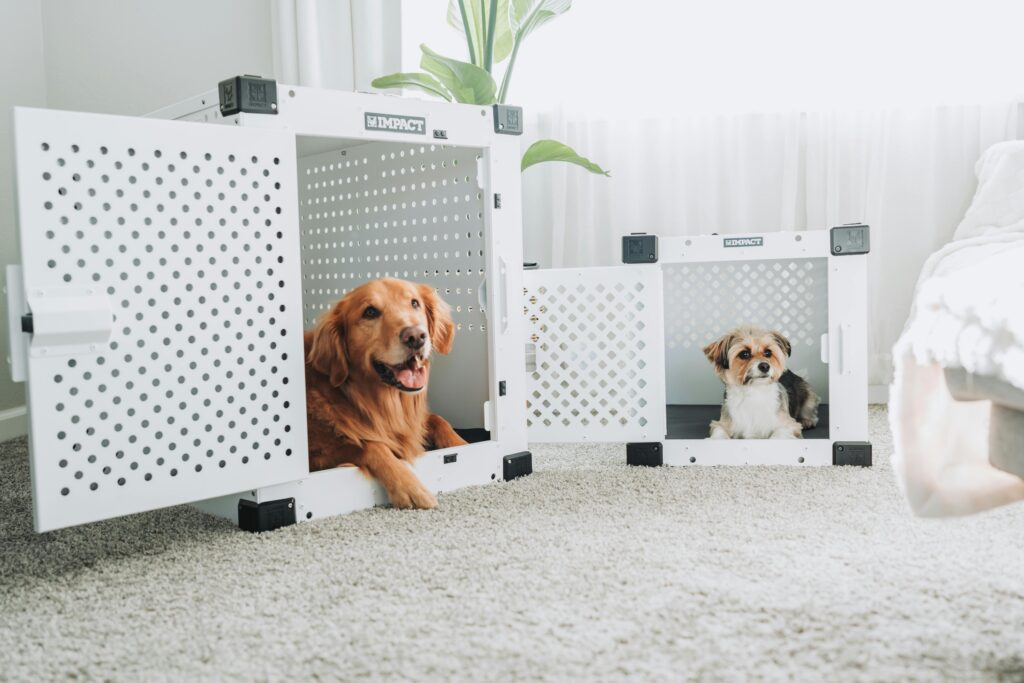| Summary Choosing between a dog kennel vs dog crate is crucial for ensuring your dog’s comfort, security, and overall well-being. Both options serve as confinement solutions, but they differ significantly in their design, purpose, and best use cases. Understanding these differences can help dog owners provide the right space for their pets, whether indoors or outdoors. |
A dog crate is a small, enclosed space designed primarily for indoor use. It creates a den-like environment for dogs, offering them a secure and cozy retreat. Crates are widely used for house training puppies, preventing destructive behaviors, and providing a safe travel solution. Because they are compact and portable, crates are ideal for pet owners who need a controlled space to manage their dog’s behavior or comfort level. However, they are not meant for prolonged confinement, as they offer limited space for movement.
In contrast, a dog kennel is a much larger enclosure, often used outdoors, though some indoor kennels exist. Kennels provide ample space for movement, making them ideal for long-term use, outdoor play, and multiple dogs.
They are typically made of sturdy materials like metal or heavy-duty plastic, ensuring durability against weather conditions and escape attempts. While kennels allow more freedom than crates, they take up more space and require more maintenance. Check out the Top-rated dog collars for Border Collies to find durable, stylish, and comfortable options for your active dog.
This comprehensive guide will compare dog kennel vs dog crate in detail, covering key aspects such as size, purpose, material, security, portability, and cost. By the end, you’ll have a clear understanding of which option best suits your dog’s needs.
Blog Highlights
ToggleOverview: Dog Kennel vs Dog Crate
Key Differences at a Glance
Feature Comparisons: Dog Kennel vs Dog Crate
When deciding between dog kennel vs dog crate, it’s essential to evaluate their features in detail. Each serves a different purpose and is designed for specific situations. Below, we’ll compare key aspects, including size, space, purpose, security, portability, material, durability, cost, training benefits, comfort, and maintenance. For guidance on choosing the right collar size for an Airedale puppy, check out this detailed guide.
1. Size & Space
Dog Kennel Size
Dog kennels are significantly larger than crates, often designed to provide ample room for movement. They come in various sizes, typically ranging from 6×6 feet to 10×10 feet or even larger, depending on the dog’s size and the number of dogs being housed. Some custom-built kennels are even bigger, allowing dogs to run, stretch, and engage in mild physical activity.
The spacious design makes kennels ideal for multiple dogs or large breeds that require more freedom than a crate can provide. A well-sized kennel enables dogs to move around comfortably, reducing feelings of confinement or stress. However, because they take up more space, they may not be practical for owners who live in apartments or homes with limited outdoor areas.
Kennels also require adequate planning when it comes to placement and setup. Unlike crates that can fit indoors, a kennel usually demands a designated space in the yard, meaning you need to ensure the ground is leveled and the structure is properly secured. Some owners opt for modular kennels that allow for expansion if more space is needed in the future.

Dog Crate Size
Dog crates, by contrast, are compact and enclosed, designed to mimic a den-like environment for dogs. The right crate size should allow a dog to stand, turn around, and lie down comfortably, but it shouldn’t be excessively large, as this can reduce its effectiveness for training purposes.
Crates are available in various sizes, typically ranging from 24 inches for small breeds to 48 inches for extra-large breeds. The smaller size makes them ideal for indoor use and travel, ensuring that a dog has a secure space without taking up too much room in the house.
However, because crates are much smaller than kennels, they are not suitable for extended confinement. While they work well for short-term containment, leaving a dog in a crate for too long can cause discomfort, stress, and even potential health issues, such as muscle stiffness from lack of movement. For insights on whether Airedales excel off-leash, explore this comprehensive article.

✅ Best for ample space and movement: Dog Kennel
✅ Best for compact, den-like security: Dog Crate
2. Purpose & Usage
Dog Kennel Usage
Dog kennels are best suited for long-term containment and outdoor use. They provide a controlled space for dogs to play and relax while keeping them secure within a designated area. Kennels are commonly used by dog owners who work long hours and need a safe place for their pets while they’re away.
Kennels are also ideal for multiple dogs, allowing them to interact and socialize while remaining safely contained. Unlike crates, which limit movement, kennels offer more freedom while still ensuring that dogs do not roam unsupervised.
Additionally, kennels are often used by dog boarding facilities, breeders, and rescues, as they can accommodate several dogs at once. Many kennels are designed with separate sections so each dog has its own area without feeling overcrowded.
Dog Crate Usage
Crates serve a more versatile role, primarily used for house training, behavior management, and travel. One of the biggest advantages of a crate is its ability to assist in potty training puppies—dogs naturally avoid soiling their sleeping area, so a crate helps instill bladder control.
Crates are also effective for behavioral training, particularly for dogs prone to separation anxiety or destructive behaviors. A crate can serve as a safe retreat, giving a dog a personal space where they feel secure and relaxed.
For pet owners who travel frequently, crates are essential for transportation. They are required for air travel and ensure that dogs remain safe in vehicles during road trips. Compared to kennels, crates are more portable and easier to set up indoors, making them a convenient choice for dog owners who need flexibility.

✅ Best for long-term outdoor use and multiple dogs: Dog Kennel
✅ Best for house training, travel, and short-term containment: Dog Crate
3. Security & Safety
Dog Kennel Security
Kennels are designed to be sturdy and escape-proof, with high walls and strong materials to prevent dogs from getting out. Many kennels include locking mechanisms, reinforced frames, and even roofs to prevent climbing or jumping.
However, because kennels provide more space, some dogs may attempt to dig underneath or push against the walls to escape. It’s important for owners to secure the kennel properly by using dig-resistant flooring or placing it on a concrete base.
Additionally, outdoor kennels need proper weatherproofing, such as insulated panels and waterproof covers, to ensure dogs remain protected from extreme temperatures, rain, or direct sunlight. Discover the benefits of using a harness by reading this guide on Is it advisable for a Collie to wear a harness?.
Dog Crate Security
Crates provide a more enclosed and secure space, making them ideal for dogs prone to anxiety or destructive behavior. Because crates are smaller, dogs have less opportunity to escape, and most models come with secure latches or sliding locks.
Wire crates allow visibility and airflow, while plastic crates offer a more enclosed design that can help anxious dogs feel safe. However, some dogs may try to chew through or manipulate the crate door, especially if they suffer from separation anxiety. In such cases, reinforced crates with heavier-duty materials are recommended.
✅ Best for preventing escape and securing multiple dogs: Dog Kennel
✅ Best for enclosed, den-like security: Dog Crate
4. Material & Durability
Dog Kennel Materials
Dog kennels are typically made from heavy-duty galvanized steel, chain-link fencing, or wood, ensuring long-lasting durability. Because they are meant for outdoor use, they need to withstand harsh weather conditions and potential chewing or digging.
Some kennels also feature weather-resistant coatings, preventing rust and corrosion. However, because kennels are larger and made from sturdier materials, they are more expensive and require more maintenance than crates.
Dog Crate Materials
Dog crates come in a variety of materials, each serving a different purpose:
- Wire crates – Sturdy, well-ventilated, and foldable for easy storage
- Plastic crates – Ideal for travel, providing a more enclosed and lightweight structure
- Soft-sided crates – Made of fabric, suitable for small dogs and indoor use but less durable
While crates are lighter and easier to transport, they are less durable than kennels, especially for strong or aggressive chewers.
✅ Best for outdoor durability: Dog Kennel
✅ Best for portability and indoor use: Dog Crate
5. Cost & Maintenance
Dog Kennel Cost
Kennels are generally more expensive than crates due to their larger size and sturdy materials. Prices range from $150 to over $1000, depending on size, material, and features. Custom-built kennels with added insulation, roofing, and flooring can be even more costly.
Kennels also require ongoing maintenance, including cleaning, rust prevention, and weatherproofing.
Dog Crate Cost
Crates are more budget-friendly, typically costing between $30 and $200, depending on the size and material. They require less maintenance, making them a more convenient option for everyday use.
✅ Best for affordability and low maintenance: Dog Crate
✅ Best for durability and long-term investment: Dog Kennel
Frequently Asked Questions (FAQs)
1. Can a dog stay in a kennel or crate for long periods?
A dog can stay in a kennel for extended periods as long as it has enough space, shelter, and access to food and water. However, a crate should only be used for short-term confinement, as prolonged time in a small space can cause stress and discomfort. Adult dogs can typically be crated for 4-6 hours, while puppies should be let out more frequently.
2. Is a dog kennel or dog crate better for training?
A dog crate is better for house training, potty training, and behavioral training, as it provides a den-like environment that encourages dogs to hold their bladder and feel secure. A kennel is more suitable for dogs that need outdoor containment rather than strict behavioral training.
3. Can a dog crate be used as a permanent solution?
No, a dog crate should not be used as a permanent living space. It is designed for short-term use, training, and travel. Dogs need regular exercise and interaction, so prolonged crating can lead to stress, boredom, and behavioral issues.
4. Do dogs prefer kennels or crates?
This depends on the dog’s temperament and lifestyle. Some dogs feel safer in a crate, as it mimics a cozy den, while others prefer the freedom of a kennel where they can move around. If a dog is crate-trained from an early age, they may develop a preference for it. However, outdoor dogs or large breeds may benefit more from the space of a kennel.
5. Are dog kennels and crates escape-proof?
Both can be escape-proof if properly secured. Kennels should have sturdy walls, dig-resistant flooring, and secure locks to prevent dogs from escaping. Crates should have strong latches and reinforced designs for dogs that may try to chew or push their way out. For escape-prone dogs, heavy-duty crates or covered kennels are recommended.
6. Which is more cost-effective: a dog kennel or a dog crate?
A dog crate is more cost-effective, with prices ranging from $30 to $200, depending on the size and material. A dog kennel is a bigger investment, costing $150 to over $1000, especially for larger outdoor enclosures. The choice depends on the owner’s needs, budget, and the dog’s living situation.
Final Verdict: Which One Should You Choose?
✔ Choose a dog kennel if:
- You have multiple dogs or a large breed that needs more space
- You need a long-term outdoor containment solution
- You want a controlled area for your dog to play and exercise

✔ Choose a dog crate if:
- You need a short-term containment solution
- You are house training a puppy
- You travel frequently and need a portable option

Both kennels and crates serve different purposes, and choosing the right one between dog kennel vs dog crate depends on your dog’s needs, training goals, and living situation. Investing in the right enclosure ensures that your dog remains comfortable, safe, and happy. Learn if Dachshunds require unique collars to provide the right support and comfort for their unique body shape.





